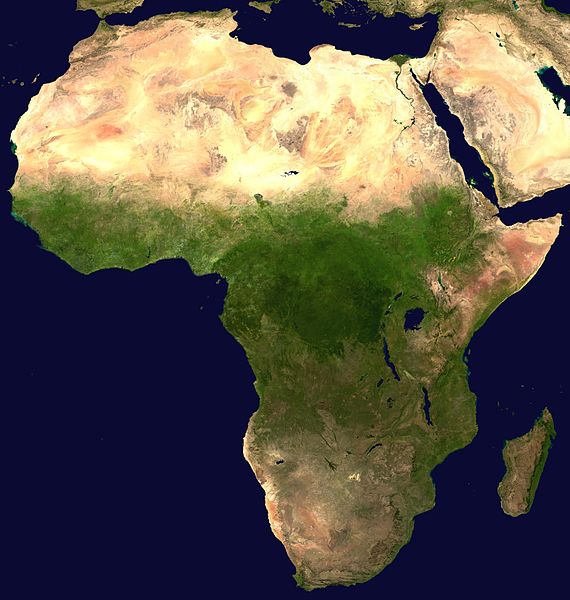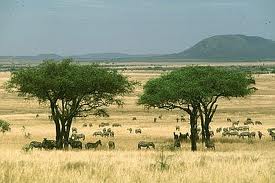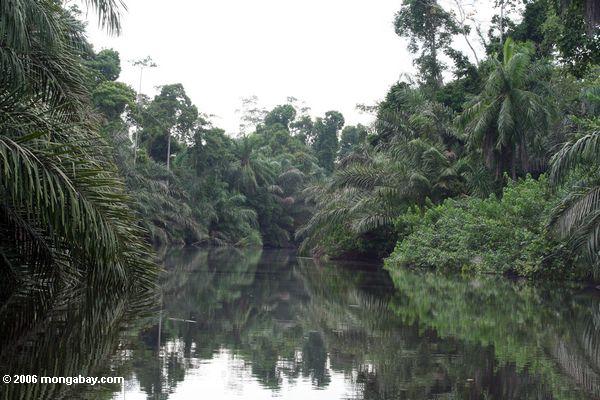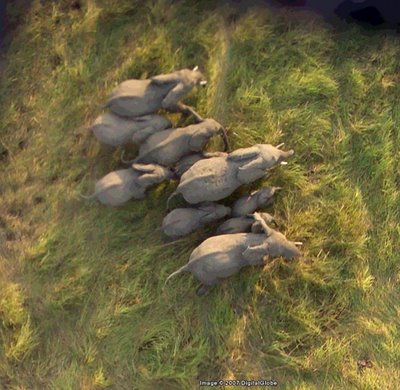The African Continent

(c) NASA
The African continent exists since more than 550 million years and is the oldest one among the five continents on earth. While other continents have drifted apart due to earthquakes and volcanic eruptions, Africa’s location has not changed very much throughout the centuries. Even today you can find plants that have existed since the age of the dinosaurs. Today Africa is the continent of thousand peoples and languages, of beautiful sceneries and impressive forces of nature.
African Countries

(c) scala z media
Africa today includes 54 countries. The biggest country by extension is Sudan, Nigeria is the most crowded one. South Africa, Kenia and Namibia are the most visited countries because of their beautiful landscapes and their wildlife parks. The smallest African country are the Seychelles. South Africa and Ghana are among the most developed countries. South Africa is also the land of the Khoikhoi and the San, also called Bushmen, who are still living the traditional life of hunters and gatherers as their ancestors did thousand years ago. They are living in the south of Africa since 25,000 years or more and have preserved their knowledge about nature until today. The rain forests of The Central African Republic as well as northern Congo and southern Cameroon are the land of the forest people. They don’t owe a country like other people or tribes. They are wandering through the forests, living only temporarily in huts. The women are gathering fruits, the men are hunting. They are trading with families living in near by villages. Like the San and the Khoikoi they have a deep knowledge of surviving in the wilderness.
African Landscapes
The African landscapes are of great variety. Africa’s north is covered by the Sahara, the biggest desert on earth. Imagine nine million square kilometres with barely any water. During the day, the Sahara Desert is like an oven, temperatures rise up to 50 degrees and more. At night, it is like a fridge, since temperature drop under zero degrees. The Libyan Desert is the sunniest, the driest and the most nearly rainless place on the planet. Only few peoples can cope with the drought of the desert. The Sahara includes sand dunes, mountain ranges, desert shrub, wadis and oases.
The Sahel is a dry, and only sparsely vegetated area, which extends on the southern verge of the Sahara Desert. It is a zone of transition between the desert and the savannas south of the Sahara. It is mainly flat, covered with dry grasslands, steppes and thorn shrublands. It is sunny, hot, dry and windy all year long. The countries of the Sahel are characterized by a long dry season. The survival of the peoples of the Sahel depends on the rain. Droughts often occur, crops fail to mature in the heat. Peoples and animals are starving. The rainy season is very short. The soils are generally poor. This is why the farmers mostly cultivate food crops such us sorghum and millet, that need not much rain.

The vast savannas of Africa can be found in West- und East Africa. Savannas are grasslands, which extend on both sides of tropical rainforests. They run from Kenya to Tanzania to southern Africa. West Africa is limited by the Atlantic, East Africa by the Indian ocean. The savannah is defined by a rainy season and a dry season. In the hot dry season, the grass withers and the bushes become leafless. Fierce lightning set fire to the bushes and trees. After that, the rain helps the savannah to blossom again. The land becomes fertile again and all animals find enough to eat. That is why once a year the migration of the animal herds takes place. Thousands of zebras, gnus and buffaloes move through the savannahs to follow the rain and the fruitful grass.

(c) Nik 06
Tropical rainforests grow in central Africa, because it rains a lot close to the equator and it is tropically warm all year long. The rainforest extends along the equator, from the Guinea coast to the Congo Basin. The equator runs almost through the middle of the continent. Congo is the region with the longest periods of rain. Farther south there are areas of flat grasslands giving way to the vast coastal plains in the east and west Africa as well as in the south. The original rainforest is an evergreen wilderness. The trees, bushes, shrubs and the infinite tangles of vines cast their leaves at different times. That is why the forests are green all year long. In the rainforest, one feels really small, because many trees are gigantic. Some grow up to 100 metres high. Every tree forms its own biotope of plants and animals. Under the high trees grow smaller trees, so the sun barely shines all the way to the ground. Colourful blossoms, fruits and exotic flowers such as orchids flourish at the forest canopy.
Southern Africa defines the area from the verges of the rain forests until Africa’s south coast. In this area, almost all landscapes of the continent can be found. Savannahs and steppes alternate with majestic mountain ranges and endless deserts. The Namib Desert is a very dry desert at the Atlantic Ocean. It ranges from Angola to Namibia. The Namib is the oldest desert on earth and has been unchanged since many million years. Its name means “empty place” and indeed is regarded as one of the most inhospitable places of the planet. The Kalahari Desert is a semi-desert made up of red sand. It is three times the size of Germany and extends across the borders of five countries. In the middle of Kalahari is an animal paradise, the Okavango Delta. The green oasis is created by the river Okavango, one of the longest rivers in Africa. It does not flow into the Atlantic Ocean but seeps away into the desert sand. In the south, the Atlantic and Indian Ocean meet. Madagascar, Africa’s biggest island, lies in the Indian Ocean.
Africa’s Mountain Ranges
A major mountain range is the Atlas Mountains in the north of Africa, which are extending through Morocco, Algeria and Tunisia. The highest peak is Toubkal, which is more than 4 000 metres high. The Atlas Mountains separate the Mediterranean and Atlantic coastlines from the Sahara. The population of the Atlas Mountains are the Berbers.
In central Africa there are the “Mountains of the Moon”, the Ruwenzori ranges, an eight-and-a-half mile long backbone between Uganda und Zaire. The highest African mountain is the Kilimandjaro, which lies between Kenya and Tansania and is known for its snow cap, though the mountain is only 200 miles away from the equator. Many of the world’s highest peaks are merely the barely-tallest points of high ranges, but Kilimanjaro stands alone, 15,000 feet above the surrounding plains. The “dormant volcano” is subject of many legends. To the east stretches the Great Rift valley containing several huge lakes.
Africa’s Lakes
The East African Rift, which extends from the Afar Triple Junction southward across eastern Africa and contains the Rift Valley lakes, which include some of the deepest lakes in the world. Lake Victoria is part of the rift valley. The lakes in this valley include some of the oldest and deepest lakes in the world, many of them are freshwater ecoregions, while others are soda lakes supporting highly specialised organisms. Part of the Rift valley is the land of the Maasai people, who are wandering through the vast plains to bring their cow herds to the best grasslands. This area lies within the boundaries of some of the most beautiful national parks such as Virunga National Park (Democratic Rebuplic of Congo), the home of the mountain gorillas, Rwenzori National Park, Queen Elisabeth National Park (both in Uganda) and Volcanoes National Park (Rwanda).
Africa’s Rivers
Most of all the African continent is formed by its rivers. Some of the world’s longest rivers drain it: the Nile river, the Congo river, the Niger and the Zambezi in the south. The longest river is the Nile river in East Africa,which runs north into the Mediterranean Sea. The Nile starts in the Great Lakes region of central Africa and runs through five countries: Uganda, Ethiopia, Sudan, Burundi and Egypt, ending in a large delta into the Mediterranean Sea. The Nile was the cradle of the first human civilisations, of ancient Egypt and the Kush Kingdom.
The River Niger, which is running through West of Africa, touches the south of the Sahara and runs into the Atlantique. The Niger was important to the founding of another ancient African civilisation: the old city of Jenné-jeno.
The Congo river in West and Central Africa, which runs into the Atlantic.
The Orange river that runs through South Africa into the Atlantique and the Zambezi River, the only long river that runs east into to Indian Ocean. There is one attraction on the Zambezi River that is internationally known: the Victoria Falls which is claimed to be the largest waterfall on earth and is a UNESCO world’s heritage site.
Africa’s Wildlife

(c) Google Earth Africa
Africa is the last remnant of past biological wealth. African tales and fables tell about the huge variety of animals living in the various regions of Africa, and also they show the respect of the people for their animals. The savannas are home to the most variety of wild animals, big herds of antelopes, gnus zebras and other animals that roam the vast grasslands. More about Africa’s Wildlife
Read more: Africa. Atlas of our Changing Environment. This UNEP publication, published in 2008, helps gauge the progress made by African countries towards reaching the United Nation’s Millennium Development Goals.–>



